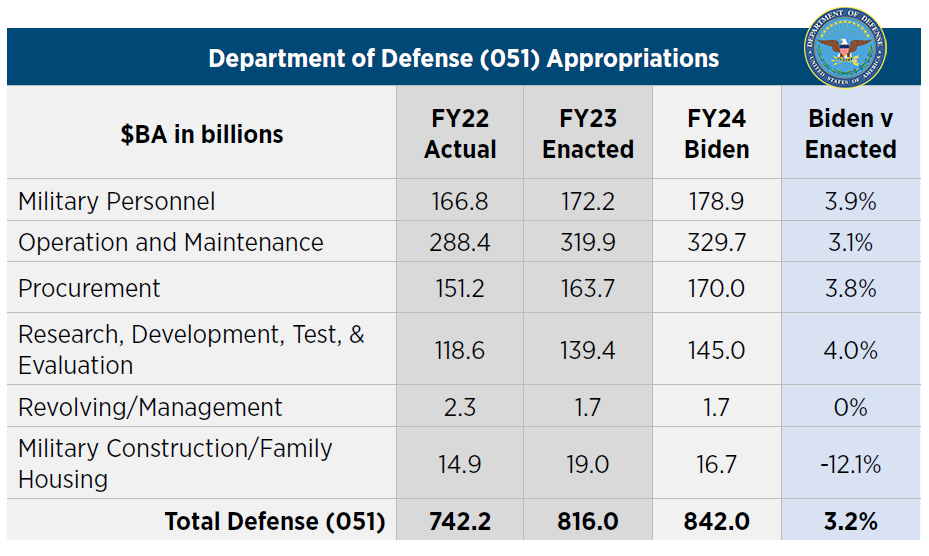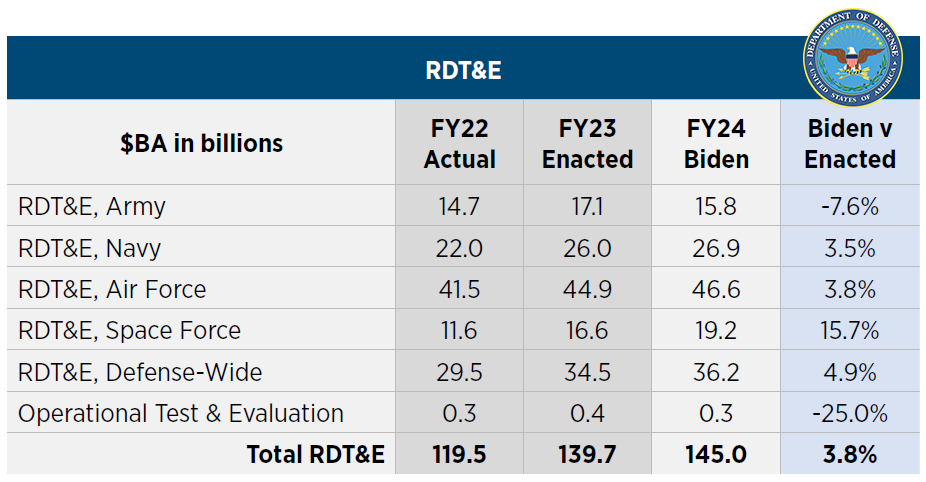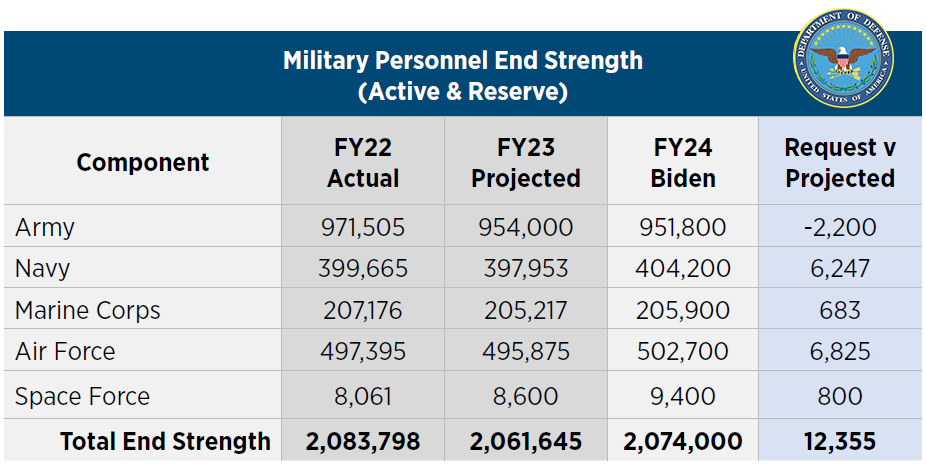

President Biden’s FY24 Department of Defense (DOD) budget was unveiled last week, and it contains a non-emergency (base) topline of $842 billion which is a 3.2% increase over the enacted FY23 base level. This is the first budget request since the National Defense Strategy (NDS) was released last fall and the numbers in this budget are aligned with that strategy. The budget reflects the NDS focus on China as our key strategic competitor and pacing challenge and with Russia remaining an acute threat to the United States and its allies. Persistent inflation remains a challenge for the Department, and Biden’s FY24 Budget fails to fully address that problem. The Department of Labor reported earlier this week that year-over-year February inflation rate for the
U.S. dropped to 6.0%. Inflation is unlikely to reach OMB’s FY23 2.3% inflation estimate by September 30.


Chart I. Source: Department of Defense. Detail may not add to totals due to rounding. Does not include emergency funding.
INVESTMENTS
For the second year in a row, Biden’s budget for DOD investment accounts (procurement and research, development, test, and evaluation or RDT&E) sets a record. The $170 billion plan for procurement and RDT&E will help the Department in its pacing challenge with China. Highlights include:
- $61.1 billion for the advancement of air power
- $48.1 billion for sea power
- $37.7 billion for the modernization of the nuclear enterprise
- $29.8 billion for missile defense
- $13.9 billion for land power
- $11 billion for a mix of hypersonic and long-range subsonic missiles with a FY24 procurement goal of 24 new hypersonic missiles while enhancing air-launched hypersonic prototype and testing.
The $33 billion space funding budget is the largest ever. It focuses on enhanced space command and control to ensure safety for military, civilian, and commercial operations.
The FY24 cyberspace activities plan is $13.5 billion. Funding will operationalize the Zero Trust framework on the military networks, advance next-gen encryption solutions development and integration, increase cybersecurity support to the defense industrial base, and fund five additional Cyber Mission Force teams, bringing the total to 147. DOD’s detailed IT budget request was not available at press time.
To address climate change, Biden’s Budget includes $3.7 billion for installation resilience and adaptation as well as $1.3 billion in RDTE for enhancing combat capability and mitigating climate risk. This includes the hardening of critical infrastructure as well as increasing platform efficiencies to mitigate contested logistics.
While defense hawks on Capitol Hill will argue this budget is too low and that it does not adequately keep up with inflation or provide real growth to the Department, the proposed budget continues to build on significant FY23 investments in innovation. The 3.8% RDT&E increase is a healthy indicator and the proposed double-digit increase for the Space Force shows real growth. Based on Chart II, Space Force funding has increased 66% in two years. While some of that due to accounting changes as it became a separate service from the Air Force, nearly $20 billion in RDT&E funding goes a substantial way towards modernization.


Chart II. Source: Department of Defense. Detail may not add to totals due to rounding. Does not include emergency funding.
Examples of DOD RDT&E priorities include $1.8 billion for Artificial Intelligence programs, $1.4 billion for Joint All Domain Command and Control (JADC2), $17.8 billion for science and technology and $4.7 billion for satellite communications.
MILITARY PERSONNEL
This budget calls for a small (12,355 person) increase in end strength with the Navy and Air Force both part of that growth with a small (2,200 person) reduction for the Army. The total end strength budget for all forces, both active and reserve is 2.074 million. Given the small end strength increase, the 3.9% overall increase in Military Personnel funding signals increased costs per servicemember and that continues to eat into the topline. The actual cost of Biden’s end strength targets may be higher. Biden’s Budget fails to account for the full cost of his proposed 5.2% military and civilian pay raise.


Chart III. Source: Department of Defense and FBIQ. Detail may not add to totals due to rounding.
OPERATION AND MAINTENANCE (O&M)
The 3.1% O&M growth rate is problematic. O&M covers a wide range of activities including costs for training and recruiting, equipment maintenance, the Defense Health Program, and civilian personnel. All these functions are impacted by inflation especially health care and training. Training and routine operations—aircraft flying hours, ship “steaming days,” “tank miles”—all involve fuel. Prices for these operations have been volatile over the past year. It’s unclear whether Congress will address the carryover effects of higher than planned FY22 and FY23 fuel prices.
WHAT’S AHEAD
We expect the impact of inflation on weapons systems, operational costs, and servicemembers to be a major factor in Congressional deliberations over the FY24 Defense budget with more aggressive oversight in the House of Representatives. Next week, Congress will ramp up its hearing process by both the Armed Services and Appropriations committees with specific attention to investment programs that align to the strategy, including hypersonics, cyber, AI, electronic warfare, and missile defense.